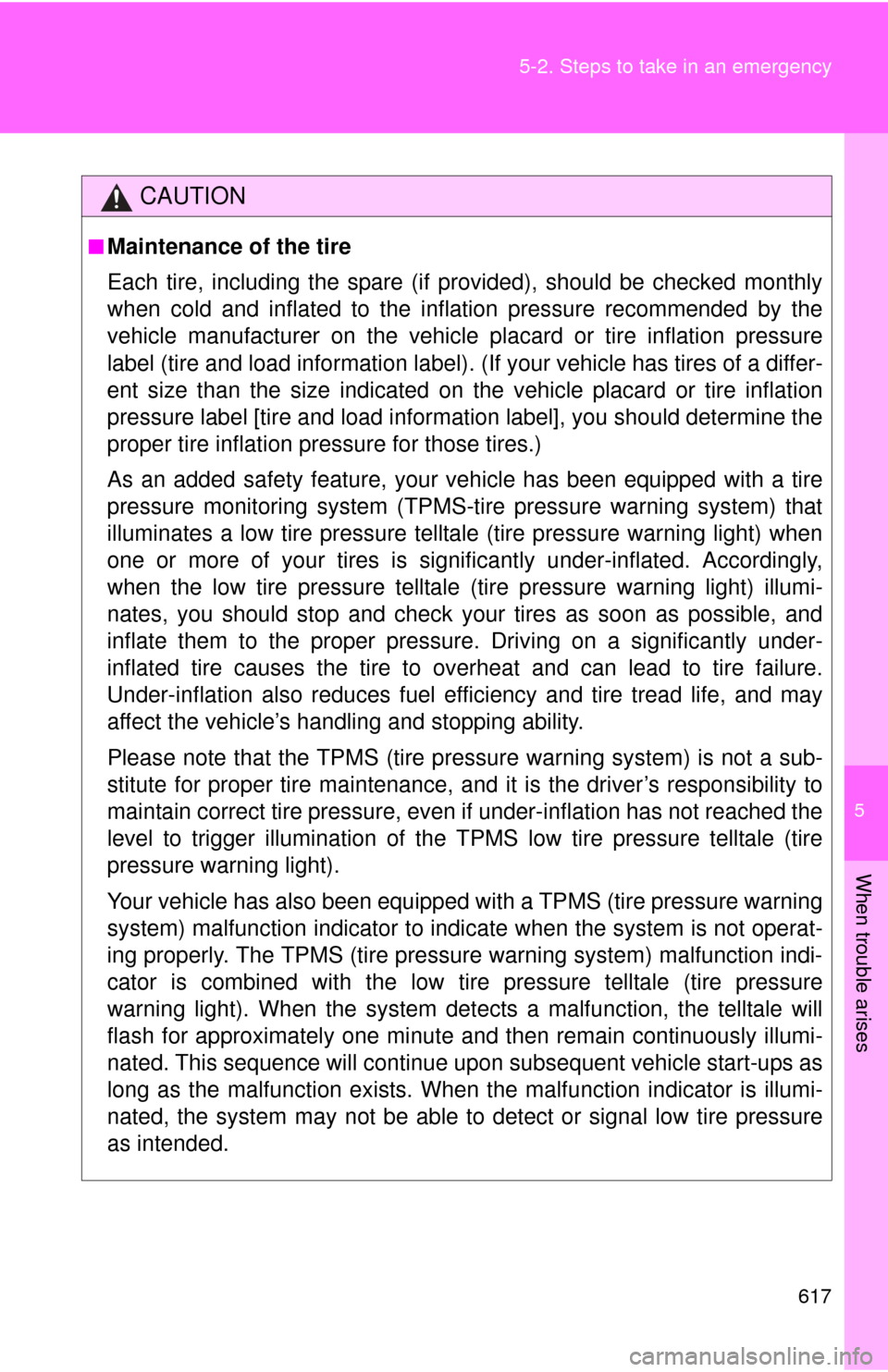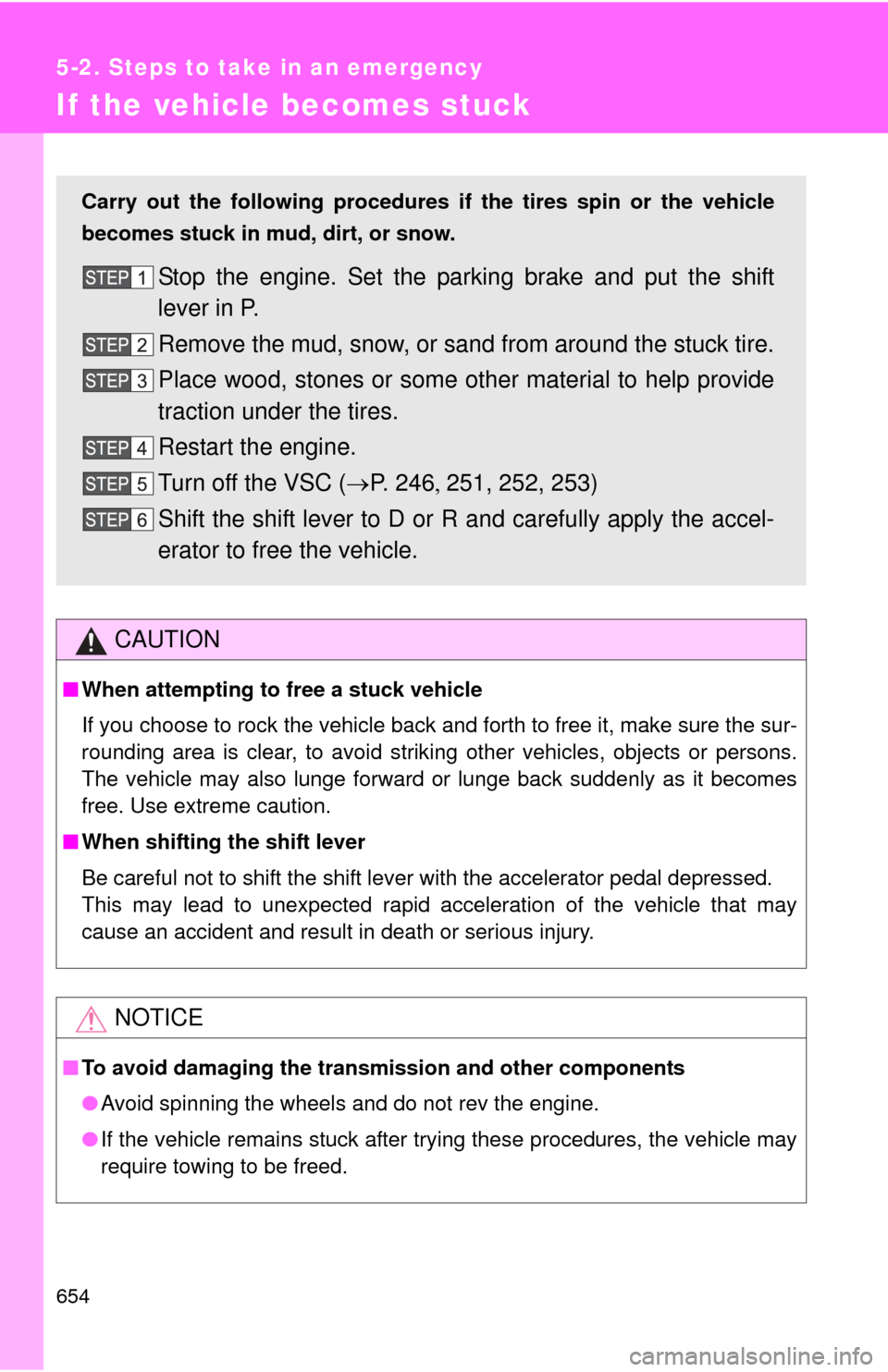stop start TOYOTA TUNDRA 2012 2.G Owner's Manual
[x] Cancel search | Manufacturer: TOYOTA, Model Year: 2012, Model line: TUNDRA, Model: TOYOTA TUNDRA 2012 2.GPages: 744, PDF Size: 15.3 MB
Page 608 of 744

608
5-1. Essential information
Fuel pump shut off system
Follow the procedure below to restart the engine after the system is
activated.Turn the engine switch to the ACC or LOCK position.
Restart the engine.
NOTICE
■Before starting the engine
Inspect the ground under the vehicle.
If you find that fuel has leaked onto the ground, the fuel system has been
damaged and is in need of repair. Do not restart the engine.
To minimize the risk of fuel leakage when the engine stalls or an air-
bag inflates upon collision, the fuel pump shut off system stops sup-
plying fuel to the engine.
Page 617 of 744

5
When trouble arises
617
5-2. Steps to take in an emergency
CAUTION
■Maintenance of the tire
Each tire, including the spare (if provided), should be checked monthly
when cold and inflated to the inflation pressure recommended by the
vehicle manufacturer on the vehicle
placard or tire inflation pressure
label (tire and load information label). (If your vehicle has tires of a differ-
ent size than the size indicated on the vehicle placard or tire inflation
pressure label [tire and load information label], you should determine the
proper tire inflation pr essure for those tires.)
As an added safety feature, your vehicle has been equipped with a tire
pressure monitoring system (TPMS-ti re pressure warning system) that
illuminates a low tire pressure telltal e (tire pressure warning light) when
one or more of your tires is significantly under-inflated. Accordingly,
when the low tire pressure telltale (tire pre ssure warning light) illumi-
nates, you should stop and check your tires as soon as possible, and
inflate them to the proper pressure. Driving on a significantly under-
inflated tire causes the tire to overheat and can lead to tire failure.
Under-inflation also reduces fuel effi ciency and tire tread life, and may
affect the vehicle’s handling and stopping ability.
Please note that the TPMS (tire pressure warning system) is not a sub-
stitute for proper tire ma intenance, and it is the driver’s responsibility to
maintain correct tire pressure, even if under-inflation has not reached the
level to trigger illu mination of the TPMS low ti re pressure telltale (tire
pressure warning light).
Your vehicle has also been equipped with a TPMS (tire pressure warning
system) malfunction indicator to indi cate when the system is not operat-
ing properly. The TPMS (tire pressure warning system) malfunction indi-
cator is combined with the low tire pressure telltale (tire pressure
warning light). When the system det ects a malfunction, the telltale will
flash for approximately one minute an d then remain continuously illumi-
nated. This sequence will continue upon subsequent vehicle start-ups as
long as the malfunction exists. When the malfunction indi cator is illumi-
nated, the system may not be able to detect or signal low tire pressure
as intended.
Page 651 of 744

5
When trouble arises
651
5-2. Steps to take in an emergency
If your vehicle overheats
If your engine overheats:
Stop the vehicle in a safe place and turn off the air condi-
tioning system.
Check to see if steam is coming out from under the hood.
If you see steam: Stop the engine. Carefully lift the hood after the steam
subsides and then restart the engine.
If you do not see steam: Leave the engine running and carefully lift the hood.
Check to see if the cooling fan is operating.
If the fan is operating: Wait until the temperature of the engine (shown on the
instrument cluster) begins to fall and then stop the
engine.
If the fan is not operating: Stop the engine immediately and call your local Toyota
dealer.
Page 654 of 744

654
5-2. Steps to take in an emergency
If the vehicle becomes stuck
CAUTION
■When attempting to free a stuck vehicle
If you choose to rock the vehicle back and forth to free it, make sure the sur-
rounding area is clear, to avoid striki ng other vehicles, objects or persons.
The vehicle may also lunge forward or lunge back suddenly as it becomes
free. Use extreme caution.
■ When shifting the shift lever
Be careful not to shift the shift lever with the accelerator pedal depressed.
This may lead to unexpected rapid acceleration of the vehicle that may
cause an accident and result in death or serious injury.
NOTICE
■To avoid damaging the transmission and other components
●Avoid spinning the wheels and do not rev the engine.
● If the vehicle remains stuck after trying these procedures, the vehicle may
require towing to be freed.
Carry out the following procedures if the tires spin or the vehicle
becomes stuck in mud, dirt, or snow.
Stop the engine. Set the parking brake and put the shift
lever in P.
Remove the mud, snow, or sand from around the stuck tire.
Place wood, stones or some other material to help provide
traction under the tires.
Restart the engine.
Turn off the VSC ( P. 2 4 6 251, 252, 253)
Shift the shift lever to D or R and carefully apply the accel-
erator to free the vehicle.
Page 732 of 744

732 Alphabetical index
Condenser ................................ 550
Console box ............................. 465
Cooling systemEngine overheating ............... 651
CRS ........................................... 140
Cruise control........................... 223
Cup holders .............................. 478
Curtain shield airbags ............. 122
Customizable features..... 203, 696
Daytime running light
system .................................... 213
Deck hooks ............................... 510
Defogger
Back window ......................... 317
Side mirrors ................... 315, 317
Dimensions............................... 658
Dinghy towing .......................... 294
Display Trip information ..................... 200
Warning message ................. 619
Do-it-yourself main tenance..... 538
Doors Door glasses ...........................96
Door lock ...........................46, 49
Open door warning........611, 620
Side doors ...............................49
Side mirrors .............................91
Driver’s seat belt reminder buzzer ..................................... 611
Driver’s seat belt
reminder light......................... 611
Driving Break-in tips .......................... 169
Correct posture ..................... 120
Driving assist systems........... 249
Procedures ............................ 168
Winter driving tips.................. 267
Driving position memory...........70
DVD player ................................ 399 Emergency flashers................. 600
Emergency flashers switch .... 600
Emergency, in case of
Blown fuse ............................ 577
If the engine will not start ...... 641
If the shift lever cannot be shifted ................................. 643
If the vehicle has
discharged battery .............. 647
If the warning buzzer sounds ................................ 609
If the warning light turns on........................................ 609
If the warning message
is displayed ......................... 619
If you have a flat tire ............. 623
If you lose your keys ............. 646
If you think something is wrong .............................. 607
If your vehicle becomes
stuck ................................... 654
If your vehicle has to be stopped in an emergency ... 655
If your vehicle needs to be towed ............................. 601
If your vehicle overheats ....... 651
Engine Compartment ........................ 543
Engine switch ........................ 178
Exhaust gas .......................... 174
Hood ..................................... 542
How to start the engine ................................. 178
Identification number............. 668
If the engine will not start ...... 641
Ignition switch ...................... 178
Immobilizer system ............... 115
Overheating .......................... 651
Warning light ......................... 610
Engine coolant Capacity ................................ 673
Checking ............................... 549
D
E